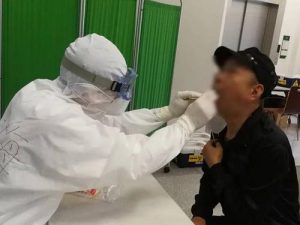नए कोरोनोवायरस के न्यूक्लिक एसिड का पता लगाने का परिणाम नए कोरोनोवायरस निमोनिया के निदान और उपचारात्मक प्रभाव मूल्यांकन के लिए एक महत्वपूर्ण संदर्भ है. न्यूक्लिक एसिड का पता लगाने के लिए स्क्रीनिंग नमूने मुख्य रूप से गहरी खांसी के बलगम या गले के स्वाब से आते हैं, जिसे विभाजित किया गया है नासॉफिरिन्जियल स्वाब और ओरोफरीन्जियल स्वैब. इसलिए, दोनों के बीच क्या अंतर है?
ग्रसनी में नासोफरीनक्स शामिल है, मुख-ग्रसनी और गला. उनकी श्लेष्मा झिल्ली सतत होती है और ऊपरी श्वसन पथ से संबंधित होती है. नासॉफिरिन्जियल स्वैब और ऑरोफरीन्जियल स्वैब के केवल नमूने लेने के रास्ते अलग-अलग होते हैं. मौखिक नमूना ऑरोफरीन्जियल स्वाब है और नाक का नमूना नासॉफिरिन्जियल स्वाब है.

कोविड-19 परीक्षण
क्योंकि ऑरोफरीनक्स स्वैब को उद्घाटन के माध्यम से संचालित किया जा सकता है, यह अपेक्षाकृत सरल है, इसलिए इसका क्लिनिक में अधिक उपयोग किया जाता है. हालाँकि, उन लोगों के लिए जो ऑरोफरीन्जियल नमूने लेते हैं, जोखिम का जोखिम अधिक है. ऑपरेटरों को अक्सर मरीज़ के मुँह का सामना करना पड़ता है. संग्रहण प्रक्रिया के दौरान, मरीजों को जलन होने का खतरा रहता है, सूखी खाँसी, उल्टी और अन्य लक्षण, जो संग्राहकों को एयरोसोल ले जाने वाले वायरस के संपर्क में लाता है. नासॉफिरिन्जियल स्वैब के ऑरोफरीन्जियल स्वैब की तुलना में कई फायदे हैं. पर्याप्त संख्या में नमूने प्राप्त करने के लिए, नमूना लेने के दौरान वे ग्रसनी में अधिक समय तक रह सकते हैं, यही कारण है कि सकारात्मकता दर साहित्य में बताई गई ऑरोफरीन्जियल स्वैब की तुलना में अधिक है. इसके साथ ही, मरीज़ों को अच्छी तरह से सहन किया जाता है, इसलिए वे आमतौर पर पहले टोपिकल एनेस्थीसिया और नाक म्यूकोसा संकुचन से गुजर सकते हैं, और कुशल नमूनेकर्ता बिना एनेस्थीसिया के मरीजों का नमूना ले सकते हैं.
















 कोविड-19 परीक्षण
कोविड-19 परीक्षण


